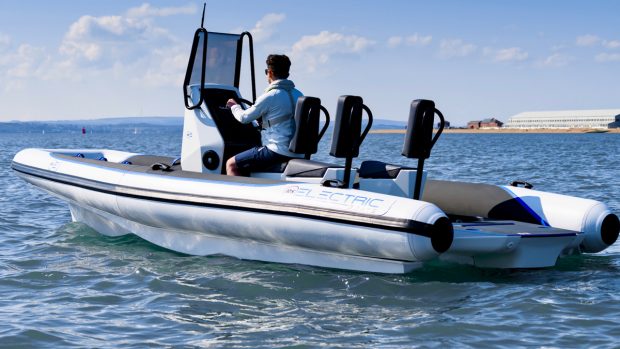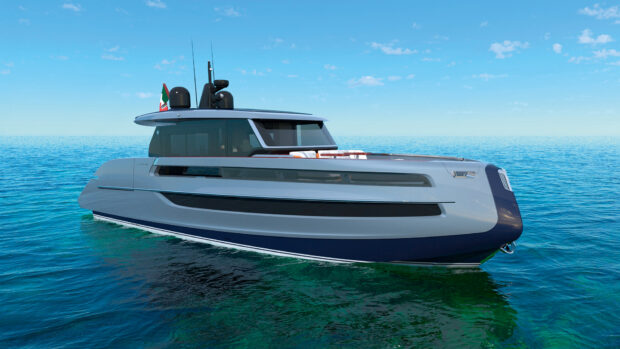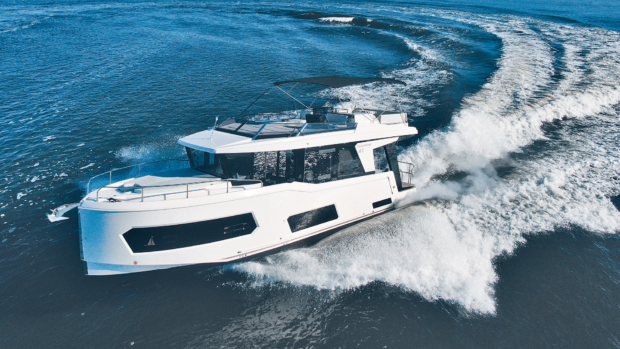The crew of Egret is treated to some turbulent weather as they hone in on their final destination
Position: S30 00.58 E178 23.21 (376.2nm to go)
Scott (YT) and Mary Flanders (MS) left Gibraltar on 16 September 2006, and we’ll be following their journey every step of the way, thanks to this unique online “blog”. For a complete list of all the couple’s blog entries click here
Friday 10 October
Well, mis amigos, this looks like being our last weekend before arriving in New Zealand. If all goes to plan we will arrive six days from now at about 2pm local time 16 October. So far this leg of the trip has been great, we have had calm seas and little wind so far and we have a waxing moon getting brighter each night. We have been running between 1625 and 1700rpm and averaging around 7 knots, give or take due to current. On the day we left we were visited by a pod of 8-10 jet-black pilot whales. We went right through where they were milling about but they went down and didn’t reappear. We have also seen humpback whales in the distance and one breaching in a huge splash. Our course is 197 degrees magnetic and the heading is 194 degrees magnetic, so we have just three degrees of set and drift, another reason behind our great speed. If the bottom of the hull was as super clean as normal we would be going even faster.
So let’s talk about navigation for a bit. To set our course we placed a first waypoint well outside Duff Reef off Nuka’ alofa, then a second waypoint in the middle of the bay leading into Bay of Islands, New Zealand, a distance of a little over 1000nm. As we get closer we’ll fine-tune the Bay of Islands waypoint. We use two navigation laptops: one has C-Map charts installed and is running all the time but is our backup computer, while the main navigation computer has C-Map charts running, as well as Map Media charts on a split-screen. Both run on Max Sea navigation software.
When we put in a waypoint it draws a line to each waypoint from the previous waypoint as well as a cross track error line on each side of the course, green to starboard, red to port. We also run north up on all our navigation (not course up).
We learnt a big lesson in the South Pacific. It is not like the Atlantic where there are no surprises. We follow the little red boat on 100,000 scale not 1M and I set our two waypoints then used a 1M scale to check the rhumb line for obstacles. It told me there were none but Mary was scrolling down the rhumb line when she found an island with our rhumb line running right through it. It’s called Ata Island and is 309m high. It reminds us of Juan de Fernandez Island off the coast of Chile. I have never heard or read anything about Ata Island. Imagine a sailboat sailing along a night with no radar, it would run the risk of driving right into this sheer cliff rock (we scanned the shore with binoculars just in case this did happen and someone was ashore).
North and South Minerva Reefs are the same but off the rhumb line from Tonga or Fiji and there is zero resolution until you drop down to 100,000 scale. The only way we found the location was by using waypoints from a friend. The bottom line here is that you really need to be diligent when cruising this area, particularly without paper charts like us.
Saturday 11 October
As we diverted past Ata Island we drove through a huge flock of tuna birds and we caught a 15lb tuna, which appeared to be an albacore tuna. Except for a little front while passing the island we have had super calm seas and little wind and the fish have been cooperating with a 20lb mahi mahi dropping by every hour or so. However, we have become so lazy and have so little freezer space left we don’t try too hard to bring them aboard.
We have received two email quotes for Lifeline AGM batteries while underway. One quote is very good and we’ll arrange to pay for them as soon as we land in Opua.
After sunset I was up from nap chores and was standing in the head when the right rigger went off and from the sound of the reel it was a big fish. All I saw was a huge splash so I ran to the flybridge to get things going and Mary was on the rod. We started the circle routine but the fish was so far out I needed to give her a hand so Mary ran the boat while I shouted instructions. We regained lots of line and it was give and take for a while but in the end we ran over the line and that was the end. This fish was a large blue marlin, well over 300lb, perhaps even 400lb. This may sound funny to you but we don’t want really large fish, although obviously we don’t have a choice over what decides to snap. From now on we’ll pull smaller sub surface baits to fill the freezer and then we’ll quit fishing.
We sure could use Master Angler Steve’s (MAS) help on this crossing. MAS reeled in many a fish on our crossing from the Canary Islands to Brazil. To release a large marlin would take more than Mary and I and it’s easier to gaff and kill a marlin than release it. However, I hope to never again kill a billfish of any kind during my fishing days. I killed my first sailfish and first marlin and that’s enough for me.
Once we reach New Zealand all fresh meat must go through quarantine inspection so we’ll go through the freezer and keep just enough for the next few days and throw out the rest. We departed earlier than we intended so have not only our meat but some that our friends onVisionleft us.
In New Zealand they also take fresh fruit, vegetables, eggs, honey and canned South American meat, among other things. We’ll throw overboard anything obvious and put anything we feel may be taken on the saloon table for easy inspection. Also before landing we’ll scrub the bottoms of all our shoes and boots, something they also check to ensure no foreign seeds come ashore. The Kiwis try hard to keep their country as clean as they can; feral cats, possums, and rats have taken their toll on indigenous birds and animals. For example, the kiwi bird is extremely rare now except on Stewart Island, south of South Island.
Sunday 12 October
We have had light and variable winds today from every direction but with no appreciable waves or wave direction and little motion aboard. We would love to divert to Minerva Reef to check it out and catch up withVisionbut we can’t let this good weather window pass. Dinner this evening was super fresh albacore tuna – as good as it gets.
Shortly After typing the last paragraphs the wind went to 25 knots on the bow pushing up choppy speed bumps. We have reduced rpm three times to smooth things out. We are currently running at 1485rpm and speed ranges from 5.5 to 6.4 knots depending on currents.
Monday 13 October
Well, mis amigos, I have been on watch for a while this afternoon watching the dynamics of the waves, how our little white fibreglass ship deals with them and how things are in constant change. Early on during this leg we had a dream trip with slight swells and very little wind or boat motion. That changed yesterday evening when a front blew through bringing short, tight and steep, smallish waves. As the night wore on the wave sets became more established in direction, higher but with a greater period of time between waves. The wind and waves were from the SSE, just a bit off the nose. After daylight the waves matured even more, rising even higher to near 2.5m, but again they were not steep. We resumed our 1625rpm and were still comfortable but with the wind on the bow, around 25 knots, we were slowed down quite a lot.
Before we left Nuka’ alofa we dropped the paravane arms. The upside is that if we are running with wind aft of the beam we get a big push from the extra wind of arms. However, if the wind is forward of the beam (as it is now) we get battered. So we are being battered speed wise but we are still comfortable.
That was before. Now the wind is trying to swing to the SE at up to 30 knots. We have occasional large wave sets from the SE mixing with the established waves from the SSE. Our set and drift has gone from the three degrees to port we reported in calm seas to 13 degrees. Our motion is not as predictable but so far so good in the confused seas. There is a lot of spray with the pilothouse glass being constantly washed in heavy spray. It is mesmerizing to watch the bow push water around and shoulder seas out of the way. Our little tough girl.
The good news of the day was an email from Opua Marina saying they will have a slip for us. We plan to stay there a bit before moving to Whangarei for a few months. We’ll then leave for the States in late January to attend the Miami Boat Show in mid-February before returning to Whangarei.
From Whangarei we’ll cruise south to South Island and then on to Stewart Island, south of South Island. We’ll probably return to Whangarei in winter, which is two hours drive north of Auckland.
Last night we had to break out the coffeecarryometer, a measuring device with its roots in the Spanish invasion of South America. It’s a simple device based on the degree of difficulty of carrying a cup of coffee from the galley fires to the poop deck – or inEgret’scase to the pilothouse. On a scale of 1 to 10, 1 is no problema, 10 is grande (big) problema. Last night, depending on the judge and participant, the coffeecarryometer was hovering around the 7-8 mark but in spite of everything Mary still fixed a full meal of steak and mashed potatoes. She is the best.
Another thing that sprung to mind last night is something that we call ‘Aquarium Glass’ (AG). AG is when spray is no longer spray but so heavy it appears to be like looking into an aquarium through the pilothouse windows. We didn’t quite reach AG levels last night but we did have heavy spray.
This morning the winds have diminished to the 20 knot range and the seas, though still confused, have dropped to the 2m or less range from up to 3m of pure slop and occasional RBGs (really big guys) rolling through. During the height of the confusion and wind we could see white foaming waves race along and crash against the port side. During the night we varied rpm, sometimes taking it as low as 50rpm and at other times up to 100rpm. We’re now running at 1615rpm making 6.2-6.4 knots. The bottom line is that the miles are receding to nearly half way. At this moment we have 634.8nm to the Bay of Islands, down from over a thousand.
During the night I heard a familiar ‘thwak’ against the side of the pilothouse. A first for the Pacific but quite common in the Atlantic we found a large flying fish lying on the side deck. They jump towards the running lights for some reason. During the Atlantic crossing to Brazil, on particularly heavy FFNs (flying fish nights) we would gather the largest in the morning and Mary would cook them for breakfast. We would gut and scale them and fry them whole in olive oil until lightly browned. The mild tasting white meat falls away from the skin and backbone similar to a small trout. Our crewman, Master Angler Steve, could really wolf them down.
Sitting here today, I am watching the seas going through their gyrations and constant changes. The wind picks up, the seas follow after, the wind diminishes or changes directions and the seas follow suit.
Finally, as predicted by OMNI Bob the winds slowly backed to the SE and then to the E. Surprisingly the seas went to the east without the cross chop normally associated with a moderate wind swing. It has been comfortable all day except for a short while when we had largish, following quartering seas. I tried something new with the Naiad controls. The right knob says following seas under the dial so we gave both of the dials a big crank nearly to the stops and this made a big difference.
This morning we were visited by a sea bird we have never seen. It was a cross between a tern and a small albatross. It flapped its wings more than an albatross but soared the same way as well. It was beautiful, with distinct black and white colour splashes on the back of its wings. I found it in the bird book, apparently it’s a Cape (Painted) Petrel. We also had a second newbie and a big one at that. At first we thought it was a wandering albatross but later found it to be a royal albatross, the largest of the albatrosses and common around New Zealand. A pair of them were working the water this afternoon aroundEgretand one of them was huge
The miles are winding down. Today we crossed into E longitude and we now have less than 400nm to go. So we are officially on the other side of the world…in the southern hemisphere. We now have three more days to go, so three more days to completely fill the freezer with fresh fish. We need just one or perhaps two more. We’ll see if the seas cooperate but OMNI Bob forecasts they will diminish from now until arrival so we’ll put a couple small baits out and see what snaps.
Mary announced a great idea today. We are arriving in NZ so much earlier than we originally planned that we’ll have time to get flights to Ft Lauderdale for the boat show, rather than go to the Miami Boat Show in February. We need boat parts of course (doesn’t every boater?) and sooner rather than later. This means we’ll be at the Nordhavn Owners’ cocktail party on Saturday night.
We hope our updates shed a little light and a ray of hope in these difficult times. Personally, Mary and I would rather be at sea where life is simpler and peaceful.
OMNI Bob’s forecast is below.
Along the direct route to northern New Zealand, expect:
Mon 13 October: ESE-E-ENE 13-21kts, gusty 25kts waves 1.5-2.5m with lowering swells S to SE 1.5-2.0m that become more SE-ESE 1.5-2.0m during Mon/pm.
Tuesday 14 October ENE-NE 12-20kts, waves 1-1.5m, occ 2m at times. Swells ESE to E 1.5-2m. Winds easing NE-N 12-18kts and possibly as low as 10-15kts with waves closer to 0.5-1m through Tue/eve/night.
Wed 15 October – arrival: NE-N 10-18kts, waves 0.5-1m. Swells ESE-E-ENE 1-2m.
Picture 1. Flying fish
Picture 2. Royal albatross









